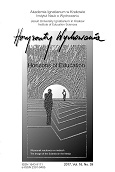Newsowy charakter artykułów o nauce w polskich tygodnikach opinii
The Newsworthy Character of Articles on Research Subjects in Polish Weekly Magazines
Author(s): Beata Czechowska-DerkaczSubject(s): Social Sciences, Education, Media studies, Communication studies
Published by: Uniwersytet Ignatianum w Krakowie
Keywords: Science; scholarship; scientists; scholars; research; image; news;
Summary/Abstract: RESEARCH OBJECTIVE: The aim of this research is to demonstrate various ways of presenting research issues in the media (taking examples from weekly magazines), which influence news releases relating to research topics. THE RESEARCH PROBLEM AND METHODS: The main research issue is to undertake research into what influences the newsworthiness of scientific/scholarly communications in the media. A selection was made of 371 articles relating to academic issues. These appeared in Newsweek, Polityka, Wprost, and w Sieci in 2016. The articles were subjected to qualitative analysis (content analysis) and quantitative analysis (the frequency of the occurrence of terms associated with research subjects). THE PROCESS OF ARGUMENTATION: The argument is in three parts. The aim of the first is to show the range of topics that most frequently occurs in articles presenting scientific/scholarly issues, and the disciplines and fields of science and scholarship that are most frequently represented in them. The second part presents an original categorization of ways of communicating information about research subjects. The third part concentrates on presenting ways of con- structing articles in news releases. RESEARCH RESULTS: In articles dealing with research topics, controversial issues appear most frequently, above all those drawn from the biological sciences and from medicine, but also from the humanities and the social sciences. The interdisciplinary presentation of academic issues stands out. These issues are selected because of they involve original discoveries and unusual phenomena. This is underlined by often sensational titles and headers that draw readers’ attention. Scientists and scholars most frequently appear in a positive light as experts and authorities in their fields. CONCLUSIONS, INNOVATIONS AND RECOMMENDATIONS: The newsworthy character of articles on research-related subjects in weekly magazines, on one hand, is part of the sensational nature of contemporary media content, but, on the other, it also makes it possible to popularize difficult research issues. It is essential for professional communicators to become more involved in this matter, and for scientists and scholars to set an agenda relating to science/scholarship. This is because the media have a very important and positive role to play in popularizing science and scholarship and in shaping the image of scientists and scholars.
Journal: Horyzonty Wychowania
- Issue Year: 16/2017
- Issue No: 39
- Page Range: 115-133
- Page Count: 19
- Language: Polish

